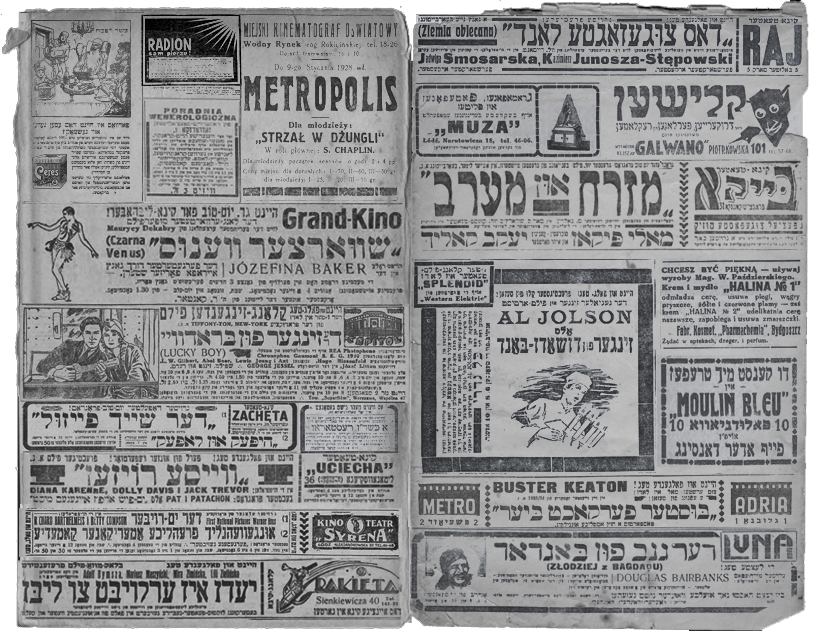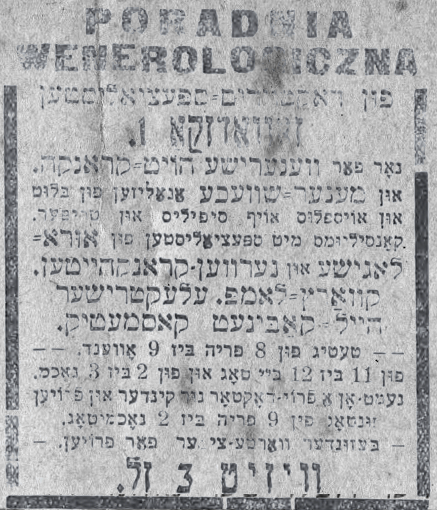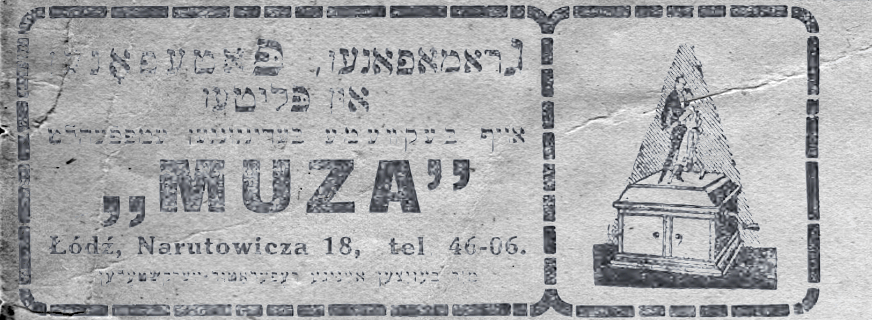Jewish Cinema in Łódź
At first, films were presented within traveling exhibitions and variété shows, in which these films took the place of earlier forms of visual entertainment, such as moving wax figures, dioramas, and keiserpanoramas. Illusions of moving figures or three-dimensional images had been developed to meet audiences’ appetite for Łódź magic experience of living pictures. In the last decades of the nineteenth century, several inventors experimented with capturing images on film. As exhibits featuring these inventors’ precursors of film toured Europe, they visited Łódź. Thus, in 1891, the citizens of Łódź could view moving images of vaulting horses and marching armies thanks to the electrotachyscope—Ottomar Anschütz’s invention that took the continent by storm during that year.
In 1896, while the Lumière brothers were introducing their cinématographe to the world, Edison’s device, probably the kinetoscope, was presented in Łódź. The device projected short films that depicted both everyday situations and exotic scenes. The Lumières’ invention was shown in Łódź during the following year. The demonstrations of these early films mainly took place in the lavish Helenów Park, the private playground for Łódź’s high society.
The visiting film presentations were so successful that already in 1896, Władysław Krzemiński included “live pictures” as a permanent element of the show in his Cabinet of Illusions at Piotrkowska Street 17, a location that continued to serve as a film venue until the outbreak of World War II. Such film screenings in various places of entertainment continued to proliferate, but by 1899, the Krzemiński brothers established a venue focused primarily on cinematic screenings. Theirs was possibly the earliest dedicated cinema establishment in the Polish territories. The necessary equipment and movies for their shows were imported from abroad. The Krzemiński brothers’ movie theater enterprise frequently changed locations. Although there was the occasional Polish film, it was French films, especially the enchanted visual spectacles created by Georges Méliès, that most enthralled local audiences.
By the end of the first decade of the twentieth century, Łódź boasted about a dozen permanent cinema-theaters. Urania, at the corner of Piotrkowska and Cegielniana Streets, was built in 1907 by Teodor Jounod. His son became a favorite of interwar film audiences under the stage-name Eugeniusz Bodo. Among the early cinema-theaters, those that kept their doors open through 1939 were Odeon (later Metro) and the oldest cinema-theater in the Jewish quarter, Flora (later Era and Kos). Both these theaters were backed by Jewish sponsors; Jewish entrepreneurs also invested in some of the other cinema-theaters. It was typical of these early cinema-theaters to continue presenting the mixture of entertainment genres that was characteristic of vaudeville; or, at least, to present films next to cabaret performances.
In the early years of cinema, projections took place in venues that were far from ideal. Herded into cramped, unsafe spaces, the customers had to tolerate poor ventilation and inadequate heating. Cinema owners in Łódź encountered daily challenges in operating delicate equipment without having quick access to replacement parts or even public electricity, as the city had none. Running a movie show required ingenuity and technical savvy.
The construction of the electric power plant for Łódź in 1907 radically changed the situation. Access to a reliable and plentiful source of electric power facilitated large-scale shows that were presented in spacious venues equipped with modern conveniences. More stringent safety codes were imposed by local authorities in the aftermath of a series of disastrous fires in theaters abroad. As permanent dedicated cinema-theaters were being established, venues for films accommodated increasingly larger audiences. Early screenings in Łódź typically seated 30 and allowed for about 60 more standing guests (though before a safety code was imposed, it was typical to pack double that number into the standing-room section). By the 1910s, the larger cinema-theaters could seat upward of 300. The new cinematograph Casino that opened in 1911 seated about 1,000 spectators!
Casino took the concept of comfort to a new level: it was the most lavish theater in the Polish lands under Russian control. The press, which was abuzz with glowing praises of the new venue, especially mentioned the arched ceiling, which was skillfully lit with electric light to underscore the architectural design, and frescos executed by respected artists, the Jewish Dawid Aleksander Haltrecht among them. But the commentators’ greatest approval was reserved for the “self-opening” theatre seats! Casino’s competitor, Luna, was smaller but could rival the former in splendor. Luna boasted a wide marble staircase, leading to a spacious foyer, and crystal chandeliers. The theater was lit with electricity and heated with steam. In contrast, cinema theaters that catered to the poor featured no such luxuries and often had difficulties meeting basic safety requirements.
Sound was an important element of cinematic screenings, even during the era of silent film. Owners of cinema-theaters, especially in poor neighborhoods, often hired narrators. They read the dialogues and captions out loud for the mostly illiterate audience. A vivid depiction of a film screening in a working-class cinema is offered by Israel Rabon, who grew up in Bałuty, in a passage from his Yiddish-language novel, The Street (Di gas, 1928).
Music accompanied living pictures from the start: music served not only to illustrate the events on the screen but also to mask the noise of the projector. In the early years, the marvel of moving pictures was often complemented by technical novelties of an acoustic nature—mechanical pianos and organs of various sorts. Unsynchronized phonograph recordings continued to be used through the 1920s. Movie spectators in Łódź came to expect and even demand musical illustration, and newly built theaters had a designated space in the front of the auditorium for a pianist or an orchestra. Among the musicians accompanying the films, it was common to find Jews; for instance, one of the most successful leaders of cinema-theater orchestras was Leon Kantor. Advertisements, especially during the early 1930s, often emphasized the presence of appropriate musical illustration, as by that decade cinema-theaters presenting silent films were competing with venues equipped to show talking pictures.
Even during the time when the artistic prospects of the new cinematic technology remained the subject of intense debate, some took notice of cinema’s educational and propagandistic potential. Already at the start of the century, local governments and organizations in Łódź and other Polish cities took steps to harness the new medium. The most lasting and influential such initiative in Łódź was the Municipal Educational Cinematograph (MEC).
The MEC was established by Aleksy Rżewski, the first mayor of Łódź after Poland regained its sovereignty at the end of World War I, and was part of a nationwide project supported by the Ministry of Religious Affairs and Public Enlightenment. As a public cinema-theater, the MEC was intended to provide low-cost access to quality films and to offer education through cinematography. The more veiled agenda for the establishment of the MEC and other such cinematic institutions was to hold back the “demoralizing” influence of the overt eroticism that characterized many of the commercial cinematic productions.
In 1922, the MEC moved into a building located at Wodny Market, near the Źródliska Park. Built in the 1870s, the structure first served the Łódź Rifle Association and later the Artisan Club; after the end of World War I, the building housed a library and the Public Municipal University. The space was renovated and adapted to new requirements in 1923: the foyer was enlarged, and the size of the auditorium was more than doubled, to nearly 500 seats. Two years later, another space was added to serve as a 300-seat lecture hall. The building also had a library and a reading room. In the late 1920s, the MEC started to build up a collection of films that could be rented out to schools.
The programming of the MEC, at least in its early years, was focused on two goals: offering films that would supplement educational programs in public schools, and providing wholesome entertainment to the working class. The fare for the former included cinematic renditions of episodes from Polish history and literature, while films for the latter included documentaries focused on nature and geography — “the cheapest way to travel around the world,” according to the advertisements.
Besides supplying inexpensive access to screenings of documentaries and artistically ambitious films, the MEC organized workshops and lectures for children, adolescents, and adults. The regular advertisements in the Yiddish-language press for film screenings taking place at the MEC indicate that its mission extended to the Jewish inhabitants of Łódź. During its heyday, the MEC served hundreds of thousands visitors a year (for instance in 1927, it had nearly 700,000 visitors). At first, prices of tickets at the MEC were the lowest in the city, and free admissions were available for qualified visitors—the unemployed, soldiers stationed in Łódź, and children from local orphanages. Concerned by the competition, owners of private cinemas were alternately applying for licenses to run similar institutions elsewhere in Łódź (already in 1922, the owner of Flora wanted to replicate a MEC in Bałuty) or trying to curtail the MEC’s operations. The MEC, however, continued to flourish, inducing the authorities to draw up plans for the construction of a larger public cinema venue and a satellite institution in Bałuty. None of these plans were realized.
By 1930, the popularity of the MEC and its revenues declined considerably; its lackluster programming failed to draw audiences, and its ticket-prices could not compete with inexpensive private theaters. Faced with the economic crisis of 1933, the municipal government was unable to cover the deficit and was forced to cease its support. The movie theater was leased out and continued to stay open until 1939, but the venue no longer focused on an educational agenda. Some time later, the building was demolished.
As the least expensive form of available cultural entertainment, film found immediate success with the impoverished residents of the Jewish quarter.
The earliest permanent cinema-theaters in Bałuty opened in 1909. These were Kasandra and Flora, the latter of which was owned by the aptly named Jan Kino (John Cinema).
In a manner typical of early cinema-theaters, the venues in the Jewish quarter at first presented films within the context of variété theater, alongside acrobatic spectacles and magic shows. Information about specific performances demonstrates that the connection of cinematic screenings to vaudeville persisted into the next decade. A good example of this practice includes performances in 1914 at the Flora of a troupe under the direction of Stanisław Szosland. By the 1920s, however, the vaudevillian extras were shed in favor of double-feature cinematic shows. Still, when not used to present films, the cinema-theaters in Bałuty (and elsewhere) hosted cabaret and revue performances.
In 1927, Łódzki Przegląd Teatralny published an interview with the owner of the cinema-theater Syrena (the new name of the Kasandra theater) under the title “First-rate cinema in the Bałuty quarter.” The article was, in fact, a thinly veiled advertisement for this venue. Syrena, vying with Flora and Macierz (later Venus) for audiences, was in actuality a second-rate theater. Like other cinemas in Bałuty, it presented films that premiered earlier at the more expensive locations in Łódź. There might have been truth to the article’s claim that spectators at Syrena waited for hours to see movies because of the high demand for its shows. The establishment during 1928–29 of several new cinema-theaters in Bałuty—Zacheta, Oaza, Uciecha, and Bajka—suggests that indeed there was pressing need for more cinema-theaters in the Jewish quarter.
With the introduction of the talkies, the cinema-theaters that could not afford the equipment for sound projection were compelled to provide their audiences with better live music. During that period, nearly all of Bałuty’s cinema owners put additional resources into hiring larger instrumental ensembles to offer fitting musical illustration.
By 1932, two venues in Bałuty—Bajka and Raj—were equipped to broadcast sound. A year later, five more cinemas in the quarter could play the talkies. This development coincided with the same transition to sound elsewhere in in the city and Poland. The reign of silent film had ended.
Over the years, there were repeated efforts to create a public film venue in Bałuty. In 1922, Berek Baumgart, the owner of the cinema-theater Flora, asked for a license to screen the same movies as the Municipal Educational Cinematograph (MEC) so that the schoolchildren and youth of Bałuty could have access to “appealing and educational” films. This request was not granted because the city authorities did not agree to the tax break proposed by Flora’s owner. In 1927, when the low-cost, high-quality films offered at the MEC were attended by hundreds of thousands, Łódź’s government outlined a plan to establish a sister institution in Bałuty. Among the proposed ideas, the most impressive was the project for a new building at the corner of Brzeska and Sporna Streets. The structure was to accommodate a 1200-seat auditorium, a lecture hall for 300, a library, and a reading room. The project was thwarted by the city’s inability to meet the high price for the land at this location.

























